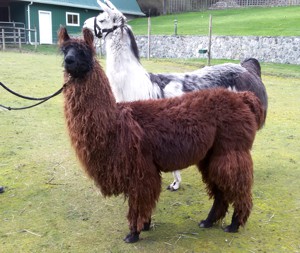About Llamas: Llama Care
Handling and Care

If you are familiar with the care of other domestic livestock you will find llamas comparatively easy to care for, with a minimum of veterinary assistance required. If you have a new llama and are uncertain of its health, consider isolating it in sight of but separate from your others for the first two weeks to prevent accidental introduction of any illnesses, and to give you both a chance to get acquainted. Make sure it is eating and ruminating, and eliminating pelleted feces.
If you have not already done so, this is the time to locate a veterinarian in your area. If he or she is inexperienced with llamas, information and assistance is available by joining groups such as Llama Canada and being in contact with other llama organizations in your area. Of course, there is also plenty of information available via the internet as well but it is preferable to have some personal contacts to call on in times of need.
Llamas are amazingly hardy animals and have very few problems with disease. To ensure good health however, there should be regular dung pile cleaning and have a preventative medicinal program of vaccinations and parasite control. Llamas should be de-wormed at least every six months.
Be sure to check with your veterinarian to see if any vital trace elements or minerals are deficient or present in toxic amounts in your area. Consult your veterinarian for other preventative medicine suggestions or to see if any special circumstances (ie: meningeal worm, selenium levels, toxic plants, etc) are a problem in your area.
Llamas thrive in a wide array of temperate environments throughout Canada and the United States. They are highly adaptable feeders, being both grazers (grasses and forbs) and browsers (shrubs and trees).
Llamas have a low protein requirement due to their efficient digestive systems and can be kept on a variety of pastures or hay. They eat about 2-4% of their body weight in dry matter each day. Without a pasture, a 110lb bale of hay will last an adult llama around 10 days. Llamas can be grazed 3-5 animals per acre on a moderate-producing pasture. They should have an unlimited, fresh clean water supply at all times. They tend to drink less in winter (unless water is heated) and when on lush, green pasture and more when working, lactating or in the summer heat.
Unless your llamas are pastured on hard or rocky ground, toenails will likely have to be trimmed twice a year.
Fencing can be woven wire, cattle wire panels, wooden rails or poles, chain link or electric fence. Barbed wire is not recommended. Your fences should be at least 4 feet high and dog proof if at all possible.
A three-sided shelter to provide shade and protection from extreme heat, cold, wind and rain should be provided. If you have severe chill factors in winter a completely enclosed shed may be necessary.
Heat stress should be a concern if you have hot, and especially humid summers at which time shearing or clipping may become a necessity. If you don't intend to shear your stock then a sprinkler, wading pool or small pond may be helpful in keeping your llamas cool for the summer. Heat stress can kill or cripple a llama so it is a serious matter.
If you animals are kept in a large pasture, a small 6-12 foot square catch pen will make it easier to catch an untrained llama.
Feeding and watering troughs should be clean, high enough to be free of possible fecal contamination and spacious enough to allow access by all animals. Fresh water should always be available.
